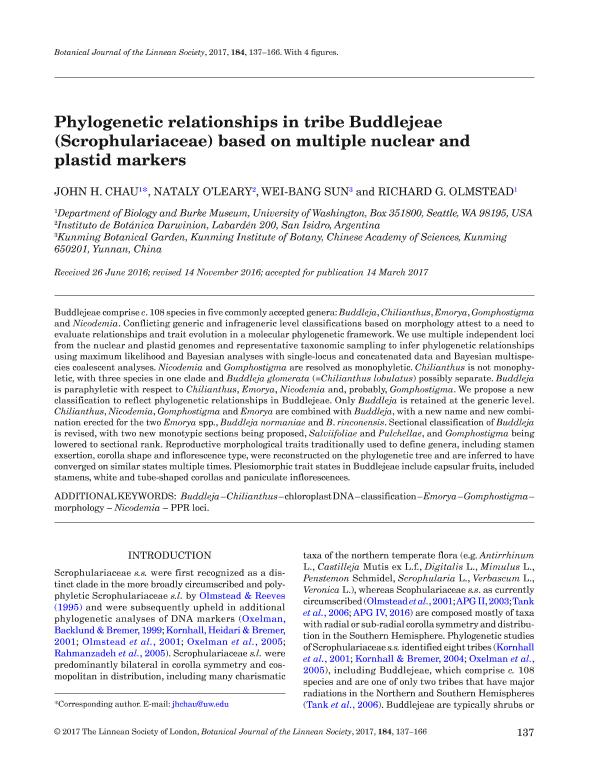Mostrar el registro sencillo del ítem
dc.contributor.author
Chau, J.ohm
dc.contributor.author
O'Leary, Nataly Cristina

dc.contributor.author
Wei-Bang, Sun
dc.contributor.author
Olmstead, Richard
dc.date.available
2018-05-04T18:37:41Z
dc.date.issued
2017-06
dc.identifier.citation
Chau, J.ohm; O'Leary, Nataly Cristina; Wei-Bang, Sun; Olmstead, Richard; Phylogenetic relationships in the tribe Buddlejeae (Scrophulariaceae) based on multiple nuclear and plastid markers.; Wiley Blackwell Publishing, Inc; Botanical Journal of The Linnean Society; 184; 6-2017; 137-166
dc.identifier.issn
0024-4074
dc.identifier.uri
http://hdl.handle.net/11336/44190
dc.description.abstract
Buddlejeae comprise c. 108 species in five commonly accepted genera: Buddleja, Chilianthus, Emorya, Gomphostigma and Nicodemia. Conflicting generic and infrageneric level classifications based on morphology attest to a need to evaluate relationships and trait evolution in a molecular phylogenetic framework. We use multiple independent loci from the nuclear and plastid genomes and representative taxonomic sampling to infer phylogenetic relationships using maximum likelihood and Bayesian analyses with single-locus and concatenated data and Bayesian multispecies coalescent analyses. Nicodemia and Gomphostigma are resolved as monophyletic. Chilianthus is not monophyletic, with three species in one clade and Buddleja glomerata (=Chilianthus lobulatus) possibly separate. Buddleja is paraphyletic with respect to Chilianthus, Emorya, Nicodemia and, probably, Gomphostigma. We propose a new classification to reflect phylogenetic relationships in Buddlejeae. Only Buddleja is retained at the generic level. Chilianthus, Nicodemia, Gomphostigma and Emorya are combined with Buddleja, with a new name and new combination erected for the two Emorya spp., Buddleja normaniae and B. rinconensis. Sectional classification of Buddleja is revised, with two new monotypic sections being proposed, Salviifoliae and Pulchellae, and Gomphostigma being lowered to sectional rank. Reproductive morphological traits traditionally used to define genera, including stamen exsertion, corolla shape and inflorescence type, were reconstructed on the phylogenetic tree and are inferred to have converged on similar states multiple times. Plesiomorphic trait states in Buddlejeae include capsular fruits, included stamens, white and tube-shaped corollas and paniculate inflorescences.
dc.format
application/pdf
dc.language.iso
eng
dc.publisher
Wiley Blackwell Publishing, Inc

dc.rights
info:eu-repo/semantics/openAccess
dc.rights.uri
https://creativecommons.org/licenses/by-nc-sa/2.5/ar/
dc.subject
Buddleja
dc.subject
Chilianthus
dc.subject
Chloroplast Dna
dc.subject
Classification
dc.subject
Emorya
dc.subject
Gomphostogma
dc.subject
Morphology
dc.subject
Nicodemia
dc.subject
Ppr Loci
dc.subject.classification
Otras Ciencias Biológicas

dc.subject.classification
Ciencias Biológicas

dc.subject.classification
CIENCIAS NATURALES Y EXACTAS

dc.title
Phylogenetic relationships in the tribe Buddlejeae (Scrophulariaceae) based on multiple nuclear and plastid markers.
dc.type
info:eu-repo/semantics/article
dc.type
info:ar-repo/semantics/artículo
dc.type
info:eu-repo/semantics/publishedVersion
dc.date.updated
2018-05-04T14:56:27Z
dc.journal.volume
184
dc.journal.pagination
137-166
dc.journal.pais
Reino Unido

dc.journal.ciudad
Londres
dc.description.fil
Fil: Chau, J.ohm. University of Washington; Estados Unidos
dc.description.fil
Fil: O'Leary, Nataly Cristina. Consejo Nacional de Investigaciones Científicas y Técnicas. Instituto de Botánica Darwinion. Academia Nacional de Ciencias Exactas, Físicas y Naturales. Instituto de Botánica Darwinion; Argentina
dc.description.fil
Fil: Wei-Bang, Sun. Chinese Academy of Sciences; República de China
dc.description.fil
Fil: Olmstead, Richard. University of Washington; Estados Unidos
dc.journal.title
Botanical Journal of The Linnean Society

dc.relation.alternativeid
info:eu-repo/semantics/altIdentifier/doi/https://dx.doi.org//10.1093/botlinnean/box018
dc.relation.alternativeid
info:eu-repo/semantics/altIdentifier/url/https://academic.oup.com/botlinnean/article-abstract/184/2/137/3865471
Archivos asociados
